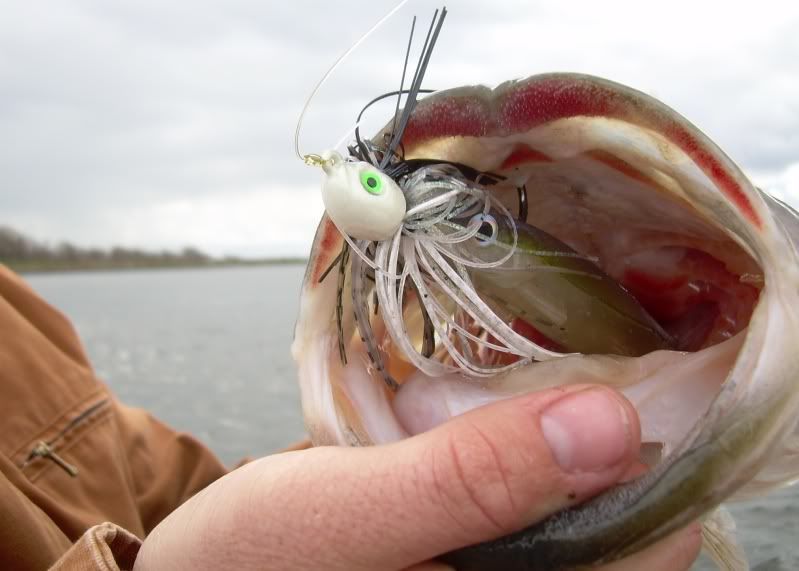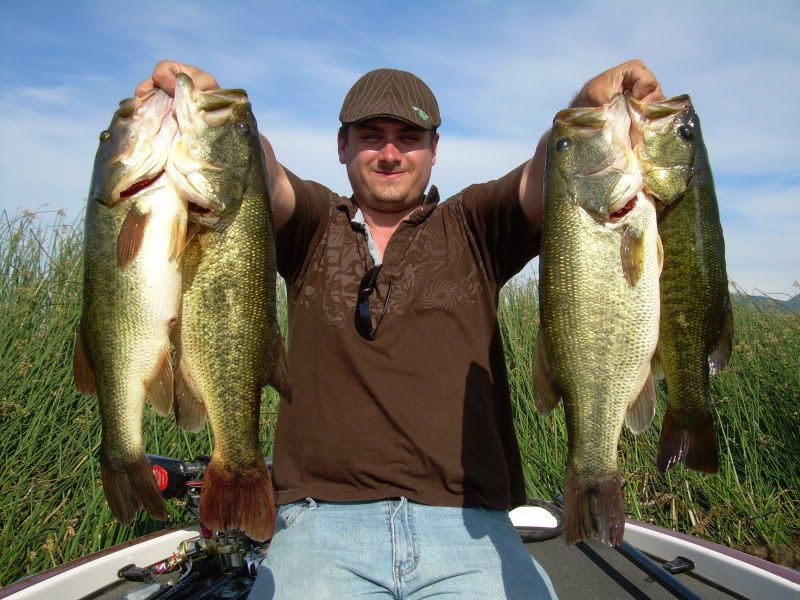This started out as a response to the post titled "swim jigs" by "Yellow Majic 33" but it became so long (as often happens) that I decided to make a new post out of it. Yellow magic... here are my thoughts on swim jigs and the questions you had.
You asked some great questions and I LOVE throwing a swim jig! I've fallen in love with this technique over the last 2 years. I was slow to grasp the full power of the technique until I began catching giants in both the daytime and night time using it. This technique has received a lot of attention in the last few months but is still very new, very fresh, and very deadly!
From everything I'm reading here on the board, I take a fairly different approach than the rest of the pack. First off, I don't use just one jig, one line, and one rod. That sounds like a great way to limit myself and ultimately lose more fish. When you properly match your equipment to the swim jig you're using, you should not be losing significant numbers of fish. Remember, once they've eaten it, you're just reeling in a jig fish, there's no magic to it. Depending on the size of fish I anticipate catching, and the cover I anticipate fishing, I make some major adjustments to my equipment in order to drive the odds further in my direction.
I'll begin with rods. I throw swim jigs on three rods, but only two of them are used on every trip. (Yes, I just said I throw a swim jig of some kind on EVERY TRIP.) Those three rods are the Dobyns 734c, Doybns 765 Flip, and Dobyns 795 SBMT (short-handle swimbait rod). I use this particular brand of rods because they match PERFECTLY with my style of fishing. That is key! You need to use rods that match your style, not the style of the guy on TV. Pick up some rods, borrow them, fish them, and find the rod that matches your style. Of the three rods I mentioned I use the 765 the most often. This rod is 7'6", is a 5 power (medium heavy to heavy) but is a moderate fast taper. I DO NOT like FAST taper rods for swim jigs (or any other jig). It is important to get a lot of rod flex when you hook a fish with the jig or they will be able to throw slack into the line and come off.
These 3 rods are matched up to 4 different jigs. They are the 3/4 ounce pitchin' jig (arkie head), the 3/4 ounce No Jack Grass Jig, the 1/2 ounce No Jack Grass Jig, and the 3/8 ounce Swim Jig. All 4 jigs are designed by Dirty Jigs Tackle. I use these particular jigs because they have made a real, measurable change in the frequency of bites, my hook up ratio, my catch ratio, and an overall size increase in the fish I'm landing. Use whatever jig floats your boat, I'm not going to push these on you, but when selecting a swim jig pay close attention to head design, hook quality/size, jig colors, and consistency/balance (quality control). Remember, the swim jig is one pattern in which the fish are honing in on what they SEE as much as what they FEEL, so it needs to LOOK right in the water. I should also add that I fish all of these jigs straight out of the package. I don�t believe it is necessary to modify the weedguards in any way. If you do choose to modify the weedguard, do not remove strands, simply flare it out to gain some flexibility. Weedguards have the important role of pinning the hook in place once the fish is hooked. This can be seen very clearly in this photo, in which a � ounce No Jack Grass Jig is pinned to the roof of the mouth by the weedguard. (This fish was NOT coming off!)

The next component is the jig trailer. There are a lot of GREAT looking trailers out there! I'm not here to push any one over another but I will share what I use as it has changed over time. I have tried Netbait, Yamamoto, Berkeley, 3:16, Optimum, Big Hammer, Robo, the list goes on and on. At this point, I've settled on three trailers that I use consistently. They are the Net Bait Paca Chunk (craw imitator), the 3:16 Minnow (Night time shad imitator) and the Roboworm EZ Shad (Daytime shad imitator). I've caught fish on virtually every trailer I listed, but these three have stood out over the last year as consistent producers of QUALITY fish. Again, use what you will but this is what my personal time on the water has shown to work in a variety of conditions and depths.
Swimming a jig is incredibly versatile! I�m going to quickly break down when/why I fish the 4 different jigs mentioned. The first is the � ounce Pitchin� Jig. This particular jig is what I use to imitate a craw, especially when fishing for fish in the 2 lb-9lb class. Everyone has their preferences but I believe the arkie-style head is great for swimming around rocks and wood. I choose brown, black, orange, and red tones with this jig and combine it with the Paca Craw Trailer. The � ounce weight allows me to swim at a medium pace while maintaining great bottom contact. It is rare to find a crawdad mid-water column so I want this jig within a foot or two of the cover I am fishing.
The � and � ounce No Jack Grass Jigs are my immediate choice when I plan to encounter large fish! The hook in this jig has a large gap, and extremely heavy wire. I fish it day and night anywhere the giants roam. This jig will handle a 14+ lber just as well as it will a 2 lber. A lot of people talk about fishing light wire hooks for swim jigs but I don�t believe this is necessary. If you adjust your rod accordingly, a heavy wire jig simply allows you to apply more pressure to the fish once hooked. Again, a swim jig is just another jig once you�ve set the hook! These two weights are very interchangeable but as a rule, if I�m fishing shallower than 8 feet in water that has vegetation I use the � ounce. In water deeper than 8 feet, or if the water is clear of vegetation, I prefer the � ounce as it provides a bit more feel. These jigs are what I couple with both the 3:16 Minnow and the Roboworm EZ Shad.
The final jig I want to discuss is the 3/8 ounce Swim Jig. As the name suggests, this is the only jig in the line that was truly designed for this purpose. The head is formed in such a way that it penetrates cover extremely well! When I plan on encountering fish in the 2-8 lb range and I plan on fishing around weeds, tullies, or other heavy cover, this is the jig to get the job done. Straight out of the package, I can throw this jig 50 feet back in moderately heavy tullies, begin a steady retrieve and it will duck, roll, and swim its way back to the boat!
This photo is of a good friend of mine holding 4 fish that we caught together using a 1/2 ounce No Jack Grass Jig combined with a ROBO EZ Shad, fishing approximately 6-8 feet deep along a hydrilla edge on a hot July afternoon.

If you combine the right jig, with the right rod, you should have no trouble putting 90+ percent of your bites in the boat! I hope this helps and that you land a giant swim jig fish on your next trip out!
Matt

